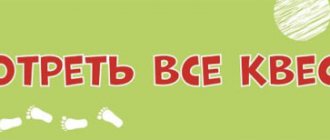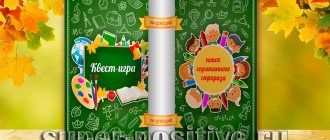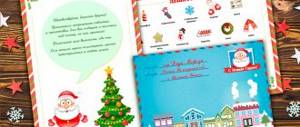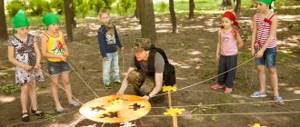If you are looking for a quest scenario for children to conduct in your apartment or house, you can choose the appropriate game option by age and theme in our catalog of ready-made quests for children. Download and print the quest on your home printer, lay it out according to the instructions, and take a camera to capture the solution process. It's simple!
And in this instruction, “Questix” will teach you how to come up with and organize a quest for children at home on your own . Don't be scared, it's not difficult and interesting. You will need a little time a couple of days before the holiday (you don’t want to rush and twitch?) and simple props: paper, markers, scissors. Want to make it more complicated? Please! Add a couple of gadgets, a combination lock and a handful of coins - you choose the difficulty of the tasks.
The main advantage of such a quest is that it “conducts itself” - it is not necessary to “learn the role”, as in a school play, and be the leader, showing your talents, the main thing is to prepare all the tests in advance and place them in the chosen places. We also recommend watching our video about preparing a home quest yourself.
On our YouTube channel you will find many more useful tips and ready-made scenarios for home quests for children - go and subscribe. We publish new videos every week.
How to come up with and arrange a quest for children at home with your own hands
- Determine who the tasks will be for: the age of the children, how many there are, whether other adults will participate or, on the contrary, help you (older children are excellent helpers). If there are more than eight children, it is better to divide them into two teams according to ability and age and make two parallel chains of clues that will not intersect, so the seekers will not interfere with each other and there will be enough tasks for everyone. And at the end, prepare a surprise for each team! Until adolescence, it is advisable not to organize competitions and rivalries. Invite dad and grandmothers to join, do a couple of more difficult tasks - they will be pleased to participate, and the children will be prompted if in doubt.
- Select a room. Prepare it: remove unnecessary, fragile, valuable - everything that players could accidentally damage in the excitement of the game. On the street, if the area is open (park, playground), figure out how to mark the boundaries of the search so that the children do not run away: stretch a string or draw with chalk.
- Look around carefully and choose the places where the quest clues will be hidden: they should not be too obvious to avoid early detection of the clue - then the quest will be shortened and disappointment is inevitable. But not entirely difficult either - corresponding to the age and ingenuity of the child. Select pieces of furniture, small objects, something that appears many times (chair, cup, window sill) - there are several of them in any house, you will have to search everything! Use different rooms, do not forget about the height of children when choosing the height of the hiding place. In open areas (if there will be other people there), make sure that strangers do not accidentally discover parts of your quest. Be sure to provide for the opportunity to receive a hint - for some action (song, dance) or simply a limited number (4-5 for the entire quest).
- From the selected places, create and write down a chain of tasks for yourself, from 5-6 hiding places for five-year-olds to 12-15 for teenagers and adults. Give the first clue personally, place it in a visible place, or your accomplice will deliver it to the door and ring the bell. Older children will be interested in receiving a mysterious SMS, a strange photo of some place in the house or a video message on their laptop, or even an envelope from the pizza delivery guy! Using the first clue, children will determine the location of the second, using the second - the third, etc. Example (in the house): lamp - backpack - chair - plant - bicycle - telephone - kettle - pillow - mug - mirror. Example (at the dacha): tree – stairs – swimming pool – sandbox – flower bed – shovel – fence – swing – wheelbarrow – firewood.
- Determine the final destination where the gift will be hidden. If there are a lot of children, make sure that everyone gets a small surprise, not just the birthday boy. Badges, tokens, chocolate medals, keychains, slimes are perfect.
We figured out the procedure. For the first time, we recommend a linear quest, in which tasks are completed sequentially. Once you have successfully completed it, you can try other types:
- Collection quest , such as the Mystery of the Hieroglyph: completing tasks, children collect puzzle pieces, having received them all, put together the dragon seal and learn the secret from the text on the back. In the pirate quest, it is possible to collect all the pieces of the treasure map only by completing all the tasks on the cards. Draw the map yourself (memorize it, burn the edges a little with a candle), mark the place with the treasure with a cross and tear it into pieces.
- Quest code : at the very beginning, provide the children with a note that already says where to look, but the message is encrypted. And they will collect the key to the code by solving the tasks.
- Quest with locks (coded or regular with keys). Give the gift right away, but it is locked (perhaps with more than one lock!). To unlock the locks, you need to complete all the puzzles. How to guess numbers? Questions (how many piglets were there in the fairy tale?), mathematical examples (according to the children’s knowledge), tasks with a trick (how many legs do the girl and her pets puppy, kitten, chicken and snake have in total?), props (count the pebbles in the bag, the amount of money in wallet) and even letters (pictures of Donkey, House, Needle and Sock are ONE).
Outdoors
Games for quests outdoors or in nature are distinguished by the presence of space. This means that there are more opportunities for competitions, an unlimited number of players and it will definitely be more fun.
Scenario
Invitations
Since you are planning a trip to nature, you need to warn about this in advance. Do this on the invitation card. Invitation example:
“My friend, to celebrate my birthday, we are planning to go out into nature. An exciting game awaits us and I can’t do it without your help. I’m waiting for you at my home on the 15th of this month, exactly at 12:00.”
Preparing for the game
If possible, it is better to prepare the playing area in advance. When this is not possible, you can resort to simple competitions. In this case, it won’t take much time to prepare.
What kinds of tasks are there for children's quests at home?
The most interesting thing is to combine tasks under one topic (but this is not necessary). Does your child dream of space, loves superheroes, reads books about spies, and collects princesses? Does your teenager use Instagram and watch video blogs? Take advantage of this! Become a storyteller for a while (and also download thematic pictures from the Internet, decorate cards with them or include them in tasks!):
- Detectives are investigating the theft of a birthday cake!
- Quest – school of superheroes! Having solved all the tasks, children will prove that they also have “superpowers” - dexterity, intelligence and friendship!
- Rapunzel is lost, the guys help other princesses find her (and the gift includes a doll of the same name!)
- The quest is an expedition to the unknown planet Gryufosan, after which children are ordained as astronauts and receive beautiful tokens with the image of the planet.
- The Kaput virus has infected your computer, and a group of friends must save important files...
The advantage of a themed quest is that you can easily include active tasks in it: the usual games with a ball, balloons, paper balls at a target or bucket, limbo, an extra chair and others. Children under 10 years old will find this interesting!
The second type of hint tasks is technological:
- SMS : anagram (a word made up of another - from BAROQUE it turns out to be a BOX, RUBBING is a PICTURE, etc., there are services for composing anagrams on the Internet) or a set of letters PLSTLNAII - PLASTILINE.
- Messages on social networks : suddenly the birthday boy had a message on his wall: Be as beautiful as an Alligator, Affectionate as a Crocodile, Be sure to be reliable and almost Invincible! The clue is in the first letters of the lines - BALCONY.
- Photo riddles : print two photos of the same place from the same angle, but change something, there will be a clue in that place.
- QR codes : the required hint picture is on the Internet, and the link is given in the form of a code that children will scan with a special program on their smartphone.
- Audio tasks : record the text of the hint on a voice recorder, change it in the voice editor application. Or speed up the music track: children will listen to it, identify it, and the name will be a clue (the song of the crocodile Gena will point to a plush crocodile, and “A soldier is walking through the city” will point to a collection of toy soldiers).
The third (and most diverse) type of tasks in the quest are text, alphabetic, graphic, logical, encrypted, digital. Let’s look at their examples in detail (we deliberately drew them “quickly”; it took about 20 minutes, along with inventing them). Let's return to the sequence: lamp - backpack - chair - plant - bicycle - telephone - kettle - pillow - mug - mirror.
Friends (5 boys and girls) gathered for Vanya’s birthday (8 years old). After tea, Vanya’s mother invites all guests to inspect their chairs. Vanya saw a piece of paper with a rebus drawn on it (there are programs on the Internet for composing puzzles, and take into account the age so that children can solve them).
We solved the puzzle. This is a lamp! We searched the lamps in three rooms and found a note with pictures.
We thought, guessed - using the first letters of the words we made up the word - BACKPACK! There are two backpacks in the house, in Vanino there is a funny little man with a crossword puzzle.
We entered all the parts of the body and see it vertically - you need to look on a CHAIR! After examining dad's chair, we found pieces of the puzzle.
Collected PLANT, new potted clue! There are a lot of flowers, we carefully looked into everything and in front of the children - incomprehensible letters and a pocket mirror.
Let's look at the inscription through the mirror (write in one word or a whole phrase) and read - BICYCLE. On the handlebars of the bike in the corridor there is a piece of paper with abracadabra hanging.
We looked at it for a long time and found the word PHONE! At this time, Vanya’s phone beeps - dad sent an SMS. “Please make me some tea!” What does it mean? Look at the TEAPOT! Below it is a strange description of the item.
It's a PILLOW! We ran to the bedroom and found a code under the pillow! And under the other is the key to the cipher (find the cipher on the Internet or come up with your own).
They became decipherers and read the word MUG. They examined the kitchen cabinet and found a piece of paper with a riddle among the cups.
It's a mirror! We rush to him, from behind the frame Vanya takes out a gift - an envelope with movie tickets for all his friends, where they are going! The children are happy, and mom took less than an hour to prepare everything. We are sure that using these instructions you will be able to create your own unique quest and delight your children.
Plot and non-plot quests
If a child avidly reads about the adventures of the young wizard Harry Potter, or watches with bated breath movies and cartoons about pirates, you should think about organizing a holiday in the same style. The birthday boy will definitely enjoy a costume event, imbued with the atmosphere of his favorite book or film.
All tasks need to be linked together according to the chosen plot.
This could be an exciting Harry Potter-style quest in the countryside, with studying at Hogwarts School of Witchcraft and Witchcraft. And teams of participants can bear the names of famous houses: Gryffindor, Slytherin, Ravenclaw and Hufflepuff. Or maybe it will be a Pirate party with a search for hidden treasures with a real map of a desert island.
Or a quest for children interested in archeology. It all depends on the preferences of the birthday boy and the imagination of the game organizers.
And further..
And if the process of preparing a home quest seems too complicated for you, you can always purchase a ready-made quest for children in a special section on our website. This will save you a lot of time and help you avoid organizational mistakes, because the scripts have already been tested in “combat” conditions, are beautifully designed and are very inexpensive. We regularly update the catalog of quests so that you can choose the appropriate option for your children by age and theme. Each quest already contains a set of tasks, instructions and recommendations for conducting it; you just need to print the quest on your home printer.
What is searching for a gift using notes?
The participant is given (or he finds it himself) a message in which he is invited to participate in the quest, and in the end to find a cache with a gift. To do this, you have to consistently find and solve clues. Hints are cards with problems and various logic puzzles. Each such note encrypts the location of the next clue.
If you find yourself on this page, it means you want to organize a similar quest event for children and give them not just a holiday with eating sweets, but an interesting and fun pastime.
We offer a ready-made quest script for children that can be easily carried out at home.
Birthday with a quest at the dacha “The Secret of Parrot Island”
Captain: “I ask everyone to leave the ship’s cabins! We arrived on one of the small islands of Papua and New Guinea to find a treasure buried by the great Russian traveler Miklouho-Maclay in 1871. We have to go through many tests.
There are many tribes living in this country, some of them still adhere to the traditions and customs of their ancestors. We shouldn’t stand out among the natives so as not to attract attention, so we need to put on makeup.”
Children, with the help of adults, do face painting for each other. Here you don’t need to draw any special patterns, we just paint the face with colored dots, lines and curls. If children are wearing swimming trunks, you can paint their arms, legs and belly. Offer to wear beaded bracelets, skirts made of colored stripes and hats made of paper.
This moment always causes a storm of emotions; do not forget to photograph the Papuans at all stages of transformation.
You can draw anything, here are a couple of real Papuans as an example :-):
Mysterious letter
If there is any small pool or barrel in which you store a supply of water for irrigation, throw a sealed bottle with a letter there in advance. If not, the “ocean” will be a bucket of water.
The captain leads the children to the place where the bottle is floating: “Look, look! Someone wrote a note and threw it into the ocean. There could be something very important there!”
We open the bottle and find an encrypted letter. You can use any cipher, I used Morse code.
Children solve the code and read the note: “Cave of the Three Parrots.” These three parrots need to be printed, colored and hung over the place where the treasure is buried or hidden. If the dacha is small and children can see this sign ahead of time, hang it at the end of the holiday.
Captain: “Oh, I know! Miklouho Maclay wrote this for us! We will find this cave. The main thing is not to lose the letter!”
Collecting coconuts
Captain: “We have a long journey ahead of us, we need to stock up on food. I suggest collecting coconuts! But this must be done quickly, in the evening crocodiles crawl onto this shore...”
The coconuts will be balls with a little water poured into them. This is a great prop for relay races at the dacha, we will use it a couple more times. (To pour water into the ball, pull it onto the switched off faucet. Turn on the water slowly; strong pressure is not needed. The ball stretches under the weight of the water and fills to the size of a tennis ball.)
We divide into teams, run 6-8 meters, grab a coconut and bring the loot to the team.
Rope labyrinth
We stretch a clothesline between the trees at different heights so that the children find it interesting to climb through. You can make the task more difficult and hold hands while going through the maze.
Captain: “There’s a giant web on our way! You need to walk carefully so as not to wake up the spider!”
Mysterious ritual
Captain: “You can’t get into the cave of the three parrots without performing a mysterious ritual! We need to do this the way the natives do before every important task!”
Here you can hold a small drum or noise workshop. It’s fun even at corporate events, and the kids will definitely love it.
You distribute country noise instruments - iron bowls, buckets, sticks, empty iron cans with change. Place the children in a circle and show them a rhythmic pattern. It can be different for different instruments: someone beats short, rare blows “there-there-there-there”, someone “ta-ta-there-there-there”. We learn to knock quietly, loudly, increase the sound from the quietest to the loudest, at the same time become silent and enter.
After learning the individual parts, we put the noise orchestra together. Children walk in a clockwise circle to attract good luck.
Narrow path
Place plastic bottles (5-6 for each team) with water at a distance of 50-60 cm in a row. This is a relay race for two teams, you have to run in a “serpentine” between the bottles. Back - in a straight line. All team players must go through the “narrow path” at speed.
Javelin-throwing
Captain: “On the way, we may be waylaid by predators and some tribes of Papuans, who are still cannibals, that is, they eat people. We need to practice throwing the javelin so we can defend ourselves in time!”
Nail a small target made of cardboard or plywood to the tree. You need to get into it with a 3 m simple straight stick. We don’t make any tip, it’s dangerous.
We give everyone 2-3 attempts, choose the most accurate, and give a small prize.
Cave of Evil Spirits
Captain: “We found ourselves in a cave of evil spirits. According to the legends of the natives, you can go through the cave only if you draw 10 portraits of these spirits and hang them on the walls of the cave... One condition! All perfumes must be different!”
Again we divide the children into 2 teams. Give each team 10 disposable plates, paint (gouache) and brushes. Children must quickly draw faces on the plates and hang them on ropes stretched between the trees using clothespins. Each team will create a funny gallery of portraits.
The captain chooses the winning team and awards: Now we can move on! You have appeased the evil spirits of the cave!
Living water
We continue to compete as teams. Now we line up the children next to each other at a distance of 50 cm, sideways to each other. Each team creates its own “chain”. Each child holds a disposable cup in his hand.
Captain: “On the way we may need “living water.” It’s not easy to get it... The water will become healing only if each of you is quick and careful!”
The first player on the team scoops up water in a wide bowl with his own glass and pours it into his neighbor’s glass as carefully as possible. And so on down the chain. There is no need to run anywhere, we just stand still and pour water. The most difficult job is for the player next to whom there is an empty plastic bottle.
He needs to get into the narrow neck and pour water. A lot of water is lost during the relay race, so we just play for 3-4 minutes, then compare the contents of the bottles. The winner is immediately visible!
Building a fortress
We select one participant from each team.
Captain: “I already spoke about the cannibals who live in these parts. So there you go! We need to be able to quickly build fortresses so as not to become their lunch!”
We distribute 15 large cardboard cups to two players. You need to quickly put together a pyramid: the bottom floor is 5 pieces, then 4, 3, 2, 1. If there are people who want to compete again, we will provide this opportunity.
Rock
Remember the water balloons we used to call “coconuts”? Now we will throw them at the rock. We use 7-10 plastic bottles, half filled with water, as a rock. We build a wall out of them on some table or just on the ground.
Captain: “There’s a rock on our way. Going around it would take too long. Let's try to break it!"
We give the children water balloons, which we used in the first competition, and ask them to throw them at bottles from a distance of 2-3 meters.
Gifts for Papuans
A small creative master class is appropriate here. You can paint rocks and sticks. You can make wonderful amulets from pasta (choose thick and short tubes that can be easily strung on a rope).
Captain: “I propose to leave souvenirs for the Papuans about our journey. We will put them at the entrance to the cave, and they will definitely take them!”
Children make crafts and put them in a certain place.
Mystery card
The captain "accidentally" finds parts of the map. You can simply cut them into squares, then putting the fragments together is very easy. You can cut it into complex shapes, then it will take some time to assemble the card.
The map should indicate the place in the country where the treasure is hidden. There you need to attach the same three parrots that we talked about at the very beginning. Children follow the map and find the right place.
Here are examples of cards (if you have time to “age” the paper with tea leaves or coffee grounds, and then singe the edges, do it)!
Advantages of our quests:
the unusual saturation of each program with an individual script; actively conducting a search game; use of original techniques; availability of game props; We love to give gifts to all our children, as for the birthday boy, a special surprise is always chosen for him. Responsibility, commitment and punctuality are our main principles! Only unity and team spirit will help the guys overcome challenges!
Give your child an adventure - order a quest for his birthday!
Quest plot
The plot of the quest “Summer Vacation” is based on the theme of children's summer holidays. Participants in the quest will have to solve tasks of medium difficulty with various puzzles on a summer theme. The main idea of the summer quest is that ten sunny bunnies approach the child (children), who congratulate them on the summer holidays and offer to play. If all the tasks are solved and the hiding places are found, then the participant(s) will definitely find the treasured gift (surprise) that the sunbeams prepared and hid for them. ◊ Beginning of the quest: We recommend starting the summer quest for children with the child (children) finding the envelope that the sunbeams sent to them. Having opened the envelope, you will find a letter with an appeal in poetic form, as well as the first task. ◊ Text of the letter: Hello, we are summer sunbeams, cheerful and playful storytellers of games. Whenever the children are on holiday, we always go to them to play. So now we came in to play. To lift the cheerful mood. If anyone is able to solve our tasks, he will be able to get that wonderful gift. Our gift lies in a secret hiding place, It is hidden, perhaps in a flower, an iron, a chest. Only the one who finds all the hiding places will take our gift with him. ◊ Completion of the quest: After the guys solve all the tasks and find all the caches, a gift will be waiting for them in the last secret cache and a final letter from the sunbeams with the text: All the caches have been found, the gift has been found! Holidays, holidays, wonderful time, Long live the holidays, hurray, hurray, hurray!









